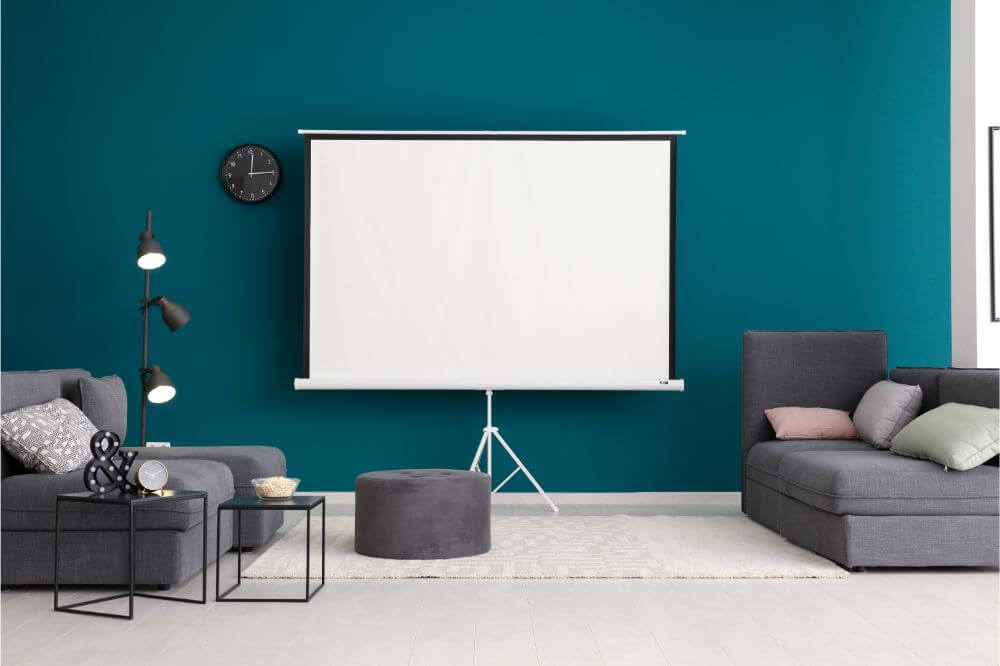Home projectors are an increasingly popular way to get large-scale entertainment at home, at an affordable price. A giant projector screen is a fraction of the price of a giant TV, after all.
In the past, home screen technology was noticeably worse in quality than a television, with issues of screen brightness, image quality, and viewing angle.
But today’s projector screens are improving more every year, and are an increasingly viable alternative. Here’s how to choose a projector screen for your home theater.
Key Considerations in a Home Theater Projector Screen
When buying a projector screen for your home theater, here are the key factors to keep in mind.
Size
The optimal size of your projection screen depends largely on the size and layout of the room where you will be enjoying it. It’s important to measure the size of the room itself, and then measure the distance from your seating area to the screen.
There is actually a mathematical ratio that determines the optimal distance based on screen size, or the optimal screen size based on viewing distance.
For example, for a screen that measures 120 inches diagonally, the audience should be seated 13-16 feet away. Here is a great calculator that helps you determine these dimensions.
Optimum Viewing Angle
Along with viewing distance, there is also the question of optimal viewing angle. Of course, everyone sitting directly in front of the screen has a good view, but what about people sitting at a side angle? Different projector screens have different viewing angles, and it’s another factor that affects both the screen itself, and the layout of the room you place it in.
Fixed Frame or Retractable?
A fixed-frame projector screen is just like the name implies — the frame of the screen is locked in place. The screen is either set up and installed permanently in your home theater, or it’s assembled and disassembled and stored between uses.
A retractable screen collapses or gets tucked away between uses. There are two main types of retractable screens:
Manual
These screens have a handle that you pull down into place during use, then retract into the housing when not in use. These types of screens are typically just hung in place, and stay flat due to the weight of the screen – they may move in air currents.
Motorized
Motorized screens lower into place with the push of a button, and then raise out of the way when not in use. These types of retractable screens are often preferred, but then the screen will need to be connected to your electrical system to operate the motor.
Border/Frame
Some screens have a narrow frame or no frame at all, while some have a thicker border. A narrow frame or no frame makes for a sleeker look and a lighter screen, particularly if you intend to store it when it isn’t in use.
A border that is 2-3 inches and black, however, improves the viewing experience: any part of the image that isn’t perfectly centered on the screen is absorbed by the border, giving your projection a cleaner look with less distraction, and a black border improves the contrast in the image, enhancing the dark colors.

Home Theater Projection Screen Additional Features
While size, angle, and screen type are the key considerations for a home screen, projection screens also have other optional features that may improve your home theater experience.
Color
While home projector screens have traditionally been white in color, there are some reasons to consider a contemporary grey screen. Grey screens absorb more of the ambient light in a room, improving the look of your projected images, and also create deeper blacks. Some screens are made of denser material with a black backing, that eliminates any light that may pass through the screen.
Gain
Many modern projection screens are treated with surface materials that improve gain. Gain is a measurement of the light reflection from the screen, so a gain of 1:1 means that the screen reflects exactly as much light as is projected onto it.
Gain of 1:5 means that the screen reflects 150% as much light. Gain is important if your home theater has more ambient light, and can also augment the properties of your projector. A projector that throws 1000 lumens will be perceived as 1,500 lumens on a screen with 1:5 gain.
Conclusion
The perfect projection screen for your home theater truly depends on the properties of the room where you will install it. Consider the size of the room, the placement of furniture, and the placement of your projector and speakers.
Consider how much ambient light is in the room, and whether you will want to use the screen during a fully darkened, cinema-like experience, or a partially lit environment for playing games or watching sporting events.
There are thousands of excellent, affordable, convenient projection screens, so you are sure to find the perfect one for your home theater.


